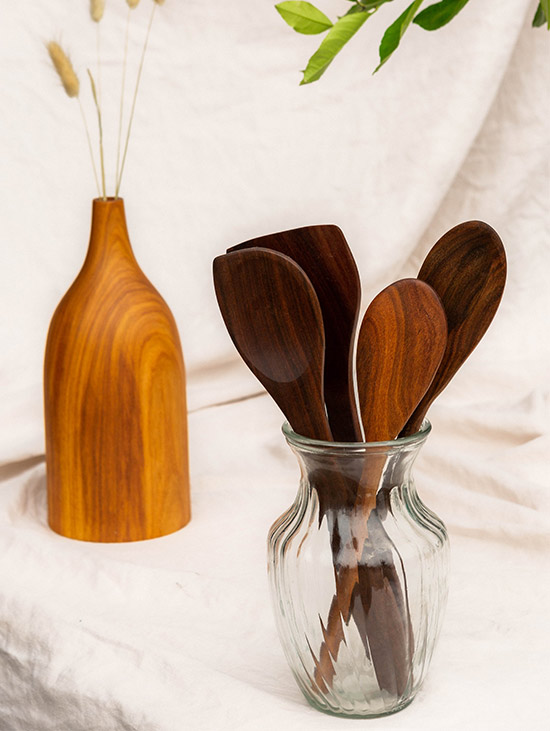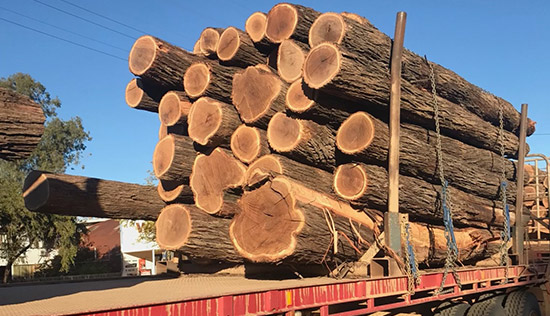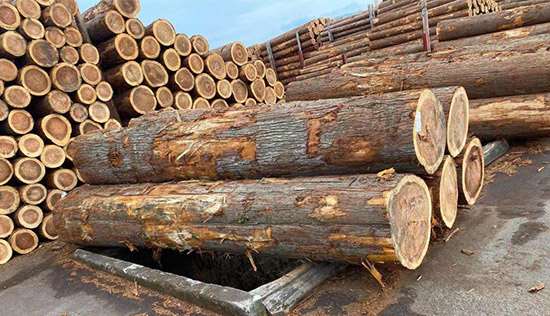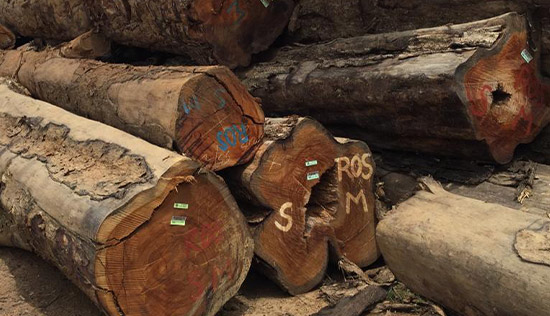
We control sourcing of raw materials, legal timber, proper permits have been acquired, respecting the tree and species. We design, test and produce our products from start to finish. We proudly use Australian grown dry land acacia as well as a Japanese plantation timber. Each species is carefully selected for each product so you get the most out of your utensils, chopping boards and grazing platters.
All of our products are made from solid wood. There are no synthetic material binding pieces together. To achieve this result, the raw material has been steadily seasoned for over 12 months in controlled conditions. The dry, raw material is then planed, sanded and finished to achieve a very appealing organic feature piece for your kitchen.
We also keep our manufacturing process as sustainable as possible by:

Majority of chopping boards and grazing platters are made using a number of pieces of wood joined together by glue. We aren’t fans of this and that’s why our products are made from long grain, solid, edge to edge Brigalow lumber. Brigalow timber, aka one of the many Acacias, is fine grain hardwood, known for being dense with a beautiful lustrous appearance. They can withstand years of use and are perfect for slicing and dicing or chopping through bones with heavy cleavers.

The biggest factor for TWK in selecting the right timber for each end use was, “is that timber stable in service”? That is, when the timber is washed, scrubbed, cut on, chopped on, left to dry in the rack and then used again and again how will it perform? Will it continue to perform for decades and even generations of users?
We selected Brigalow because it is the most suitable and best performing timber for solid chopping boards with an outstanding and visually appealing grain structure.
Some commonly seen timber species in kitchen utensils and chopping boards:
| Timber Species | Area of main Occurrence | Dry Density @ 12% MC Kg/m3 | Maximum Crushing Strength Mpa | Hardness Janka kN | Natural Durability | Grain structure |
| Brigalow | Queensland Australia | 1000 | 81 | 11 | Very high | Very fine |
| Western Red Cedar | North west America & Canada | 380 | 32 | 1.7 | Low | Coarse |
| Blackwood | Victoria & Tasmania | 640 | 48 | 5.9 | Medium | Medium |
| Black Walnut | USA | 600 | 52 | 4.5 | Medium | Fine |
| NG Rosewood | PNG, Indonesia, Solomon Is. | 620 | 58 | 4.7 | High | Coarse |
| Brown wattle | Tropical Asia and North Australia | 640 | 53 | 5.2 | Low | Medium |
| True Teak | Myanmar, Thailand, India | 635 | 50 | 4.6 | High | Medium |
| Raintree* | Tropical Asia & Central America | 560 | 34 | 3.2 | Low | Coarse |
*Raintree covers “Samanea Saman”, “Enterolobium spp” and “Pithecellobium spp.” Is the cheapest and most commonly used timber for tourist souvenirs, utensils and other table wares. It is not durable and looks similar to Brigalow.
Many timbers around the world are used for chopping board end use but most chopping boards are glued together to achieve various patterns. The glues used are synthetic while all our boards and utensils are of solid original form and not made of joined pieces. Brigalow needs substantial time to season undercover to avoid cracking and twisting. Then kiln drying is a slow and steady process. An enormous amount of time, close monitoring and care goes into each of our products, from our family to yours!
Sugi Cedar is endemic to Japan, it is commonly used in temple construction, restaurant fit outs and residential homes as wood panelling or feature walls, where natural durability and light weight are requirements. This is largely due to the availability of mature plantations of this valuable species.
Sugi Cedar is often referred to as the raw material for “Shou Sugi Ban” which is the art of surface charring externally used components to increase their longevity. Their larger diameter allows us to achieve beautiful long grain surfaces that are functional and aesthetically pleasing.
Sugi Cedar is a soft wood. It’s a quick growing and beautifully patterned timber. Sugi is pinky-brown in colour with streaks of dark and light shades. Because of its composition it is most suitable for serving platters and in situ grazing boards.
Please don’t use the Sugi Cedar boards for chopping, it will mark the softwood’s natural tones.

PNG Rosewood (Pterocarpus indicus) is known for its variation in colour, ranging from blood red to honey-gold. The grain is usually wavy or interlocked. Species occur throughout South-East Asia and Oceania. This hardwood works easily by machine and hand tools and is known for being popular for carving, musical instruments and furniture joinery. Reforestation is common practice where the removal of trees is occurring, this species is highly prized in Asia and can be hard to find in Australia. Extensive replanting in Singapore some decades ago has meant the pruning from many trees along highways is used in woodcraft.
It takes well to oiling bringing out a stunning range of colours from honey-gold to blood red grain is variable and highly figured. Pterocarpus indicus is the source of the highly prized Amboyna burr used in bespoke furniture and turnery. Originally taken back to Europe from the Dutch East Indies (Indonesia) island of Ambon where it’s remarkable and complex grain was first discovered.
